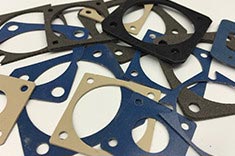EMI Shielding Products
- Custom Gasket Fabrication
- Connector Gaskets
- Bonded O Ring
- Custom Gaskets
- Conduct-O-Knit Knitted Wire Mesh
- Conduct-O-Seal Combo Gasket
- Conduct-O-Elastomer
- Conduct-O-Seal Oriented Wire in Silicone Gasket Material
- Conduct-O-Mesh Tape
- Conduct-O-Foam
- Conduct-O-Bond
- Optical Filters For Electronic Displays
- Shielded Vent Panels
- ESC Board Level Shielding
- 300 Series
What is Compounding with Conduction Fillers for Shielding EMI Solutions?
 Compounding with conductive fillers involves incorporating electrically conductive materials into non-conductive plastic matrices to impart electrical conductivity to the resulting composite. This process addresses the intrinsic nature of conventional plastics as excellent electrical insulators, typically exhibiting resistivity in the range of 10^15 to 10^18 ohm-cm. By adding conductive fillers, the electrical properties of the plastic composites can be significantly altered, making them suitable for various applications requiring electrical conductivity or electromagnetic interference (EMI) shielding.
Compounding with conductive fillers involves incorporating electrically conductive materials into non-conductive plastic matrices to impart electrical conductivity to the resulting composite. This process addresses the intrinsic nature of conventional plastics as excellent electrical insulators, typically exhibiting resistivity in the range of 10^15 to 10^18 ohm-cm. By adding conductive fillers, the electrical properties of the plastic composites can be significantly altered, making them suitable for various applications requiring electrical conductivity or electromagnetic interference (EMI) shielding.
Beyond carbon black, other conductive fillers like carbon fibers, graphite fibers, stainless steel fibers, aluminum fibers, and nickel-coated graphite fibers are also used. Each filler offers distinct advantages regarding electrical conductivity, mechanical reinforcement, and EMI shielding effectiveness. For instance, composites with continuous carbon fibers exhibit better EMI shielding effectiveness (SE) than those with discontinuous fillers, with continuous carbon-fiber composites demonstrating significant EMI SE due to their reflection mechanism.
Moreover, these composites' electrical and EMI shielding properties can be tailored by varying the type, amount, and distribution of the conductive fillers within the polymer matrix. This customization allows for the development of materials suited for specific applications, such as antistatic protection, EMI shielding in electronic devices, and the creation of conductive components for electrical applications.
When to Use Compounding with Conductive Fillers?
Compounding with conductive fillers becomes the ideal solution for EMI (Electromagnetic Interference) shielding when the following criteria are met:
- Lightweight and Flexible Design Requirements: Traditional metal shields offer excellent EMI shielding but add significant weight and rigidity. Conductive filler composites, such as those incorporating carbon or metal fibers, provide a lighter and more flexible alternative, making them ideal for applications where weight and design flexibility are critical, such as in portable electronic devices and aerospace components.
- Cost-Effectiveness: In many cases, incorporating conductive fillers into plastics for EMI shielding can be more cost-effective than using solid metal enclosures, especially for complex shapes and sizes that would otherwise require expensive machining or fabrication when made from metal. Materials like carbon black and certain metal fibers can offer a cost advantage over traditional shielding materials.
- Integrated Functionalities: When the application requires the material to possess multiple functionalities beyond just EMI shielding—such as mechanical strength, thermal conductivity, or chemical resistance—compounding with specific conductive fillers can be engineered to meet these multifunctional requirements. For example, carbon fibers can enhance mechanical strength and provide EMI shielding.
- Environmental Resistance: In environments where corrosion or chemical exposure is a concern, composites with conductive fillers can offer superior performance compared to metal shields. Certain fillers, like nickel-coated graphite fibers, combine conductivity with resistance to environmental degradation, making them ideal for harsh conditions.
Compounding with conductive fillers for EMI shielding is ideal in scenarios where lightweight, cost-effective, multifunctionality, customizable SE, manufacturing flexibility, environmental resistance, and aesthetic considerations are paramount. This approach offers a versatile and effective means to address EMI challenges across various applications.



